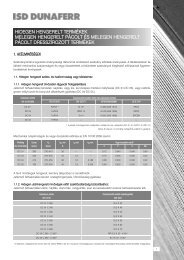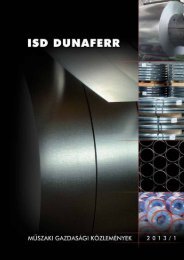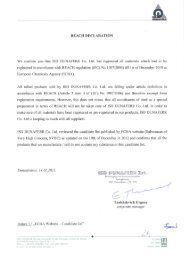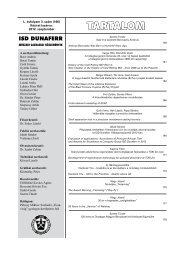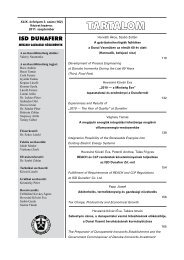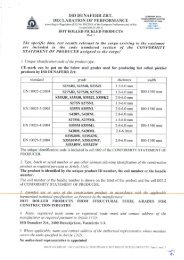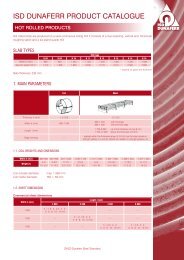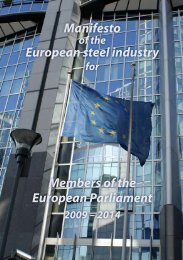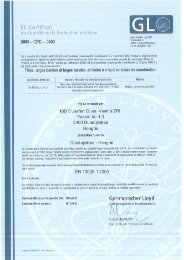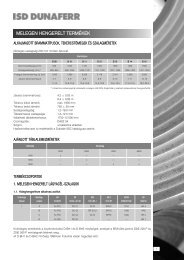SAFETY DATA SHEET Light oil (coal), coke-oven - Dunaferr
SAFETY DATA SHEET Light oil (coal), coke-oven - Dunaferr
SAFETY DATA SHEET Light oil (coal), coke-oven - Dunaferr
You also want an ePaper? Increase the reach of your titles
YUMPU automatically turns print PDFs into web optimized ePapers that Google loves.
<strong>SAFETY</strong> <strong>DATA</strong> <strong>SHEET</strong><br />
<strong>Light</strong> <strong>oil</strong> (<strong>coal</strong>), <strong>coke</strong>-<strong>oven</strong><br />
Revision:<br />
2011.<br />
according to 1907/2006/EC, Article 31<br />
1. Identification of the substance/mixture and of the company<br />
Product identifier<br />
Identification on the label / trade name:<br />
<strong>Light</strong> <strong>oil</strong> (<strong>coal</strong>), <strong>coke</strong>-<strong>oven</strong><br />
Additional identification:<br />
Crude benzol<br />
REACH registration number:<br />
01-2119519215-46-0039<br />
Relevant identified uses of the substance and uses advised against<br />
Relevant identified uses:<br />
Production of aromatic chemicals. Use as carbon black feedstock, complete conversion into<br />
carbon black.<br />
Uses advised against:<br />
use restricted to close systems<br />
Details of the supplier of the safety data sheet<br />
Manufacturer/Supplier:<br />
ISD Kokszoló Kft.<br />
2400 Dunaújváros Vasmű tér 1-3. Hungary<br />
web:<br />
e-mail address:<br />
www.dunaferr.hu<br />
csjuhasz@dbk.dunaferr.hu<br />
phone: 00.36.2558.1060<br />
fax:<br />
Information:<br />
Emergency telephone number: see: Manufacturer/Supplier<br />
2 Hazards identification<br />
00.36.25.410.614i<br />
see Section 16 (Contact)<br />
Classification of the substance<br />
According to Dangerous Substances<br />
Directive (67/548/EEC):<br />
F: R11; Xn: R20/21-63-65; Xi: R36/38; Carc. Cat. 1: R45; Muta. Cat. 2: R46 ; T: 48/23/24/25;<br />
N: R51/53; R67<br />
According to CLP regulations (EC)1272/2008:<br />
Flam. Liq. 2 H225; Skin Irrit. 2 H315; Eye Irrit. 2 H319; Asp.Tox.1 H304; Repr.2 H361;<br />
Muta.1B H340; Carc.1A H350; STOT SE 3 H336; STOT RE.1 H372; Aquatic Chronic 2 H411<br />
1. page
<strong>SAFETY</strong> <strong>DATA</strong> <strong>SHEET</strong><br />
<strong>Light</strong> <strong>oil</strong> (<strong>coal</strong>), <strong>coke</strong>-<strong>oven</strong><br />
Revision:<br />
2011.<br />
according to 1907/2006/EC, Article 31<br />
Label elements according to CLP regulations (EC)1272/2008<br />
Hazard pictograms:<br />
Signal word:<br />
Danger<br />
Hazard statements:<br />
H225 Highly flammable liquid and vapour<br />
H304 May be fatal if swallowed and enters airways<br />
H315 Causes skin irritation<br />
H319 Causes serious eye irritation<br />
H336 May cause drowsiness or dizziness<br />
H340 May cause genetic defects<br />
H350 May cause cancer<br />
H361 Suspected of damaging fertility or the unborn child<br />
H372 Causes damage to organs through prolonged or repeated exposure<br />
H411 Toxic to aquatic life with long lasting effects<br />
Precautionary statements:<br />
P210 Keep away from heat/sparks/open flames/hot surfaces. No smoking.<br />
P243 Take precautionary measures against static discharge.<br />
P260 Do not breathe mist/vapours.<br />
P301+P330+P331 IF SWALLOWED: rinse mouth. Do NOT induce vomiting.<br />
P303+P361+P353 IF ON SKIN (or hair): Remove/Take off immediately all contaminated<br />
clothing. Rinse skin with water/shower. Remove/Take off immediately all contaminated<br />
clothing. Rinse skin with water/shower.<br />
P403+P233 Store in a well-ventilated place. Keep container tightly closed<br />
P405 Store locked up.<br />
P501 Dispose of contents/container to recycling in accordance with national/international<br />
regulations.<br />
2. page
<strong>SAFETY</strong> <strong>DATA</strong> <strong>SHEET</strong><br />
<strong>Light</strong> <strong>oil</strong> (<strong>coal</strong>), <strong>coke</strong>-<strong>oven</strong><br />
Revision:<br />
2011.<br />
according to 1907/2006/EC, Article 31<br />
Information pertaining to special dangers for human and environment:<br />
Benzene, toluene, xylene and naphthalene: resorption through skin is possible.<br />
3 Composition/information on ingredients<br />
Chemical characterisation:<br />
<strong>Light</strong> <strong>oil</strong> (<strong>coal</strong>), <strong>coke</strong>-<strong>oven</strong><br />
EG-No. 266-012-5<br />
CAS No. 65996-78-3<br />
Hazard ingredients:<br />
EG-Nr.<br />
CAS-Nr. Bezeichnung Anteil<br />
[%]<br />
Richtl. 67/548/EWG<br />
200-753-7 71-43-2 benzene 60 – 70 F, Xi, Xn, T;<br />
R11-36/38-45-46-<br />
48/23/24/25-65<br />
203-625-9 108-88-3 toluene 10 – 20 F, Xn; R11-38-<br />
48/20-<br />
63-65-67<br />
215-535-7 1330-20-7 xylene<br />
(o,m,p)<br />
Einstufungx<br />
VO (EG) Nr.1272/2008<br />
Flam. Liq. 2, H225, Carc.1A H350,<br />
Muta. 1B H340, STOT RE. 1 H372,<br />
Asp. Tox. 1 H304, Eye Irrit. 2 H319,<br />
Skin Irrit. 2 H315<br />
Flam. Liq. 2 H225, Repr. 2 H361d,<br />
Asp. Tox. 1 H304, STOT RE 2 *<br />
H373, Skin Irrit. 2 H315,<br />
STOT SE 3 H336<br />
1 – 10 Xn; R10-20/21-38 Flam. Liq. 3 H226, Acute<br />
Tox. 4 H332, Acute Tox. 4<br />
H312, Skin Irrit. 2 H315<br />
202-049-5 91-20-3 naphthalene 1 – 5 Xn, N; R22-40-50/53 Carc. 2 H351, Acute Tox. 4 H302,<br />
Aquatic Acute 1 H400, Aquatic<br />
Chronic 1 H410<br />
4 First aid measures<br />
General information:<br />
Call a physician immediately. Remove contaminated, saturated clothing immediately. Remove<br />
breathing apparatus only after s<strong>oil</strong>ed clothing has been completely removed.<br />
In case of inhalation:<br />
Remove casualty to fresh air and keep warm and at rest. In case of irregular breathing or<br />
respiratory arrest use artificial respiration equipment.<br />
In case of skin contact:<br />
Subsequently wash off with water and soap and rinse thoroughly.<br />
In case of eye contact:<br />
After contact with the eyes, rinse with water with the eyelids open for a sufficient length of<br />
time, then consult an ophthalmologist immediately.<br />
In case of ingestion:<br />
Rinse mouth immediately and drink plenty of water, to which activated char<strong>coal</strong> may be<br />
added. Do NOT induce vomiting.<br />
Most important symptoms and effects, both acute and delayed:<br />
3. page
<strong>SAFETY</strong> <strong>DATA</strong> <strong>SHEET</strong><br />
<strong>Light</strong> <strong>oil</strong> (<strong>coal</strong>), <strong>coke</strong>-<strong>oven</strong><br />
Revision:<br />
2011.<br />
according to 1907/2006/EC, Article 31<br />
The following symptoms may occur: contact with skin may cause redness or blistering,<br />
inhalation may cause drowsiness and other narcotic effects. Irritation to the throat may also<br />
occur upon ingestion.<br />
Information to physician:<br />
Long term monitoring of haematological parameters can be necessary.<br />
5 Fire-fighting measures<br />
Extinguishing media:<br />
Water spray jet, CO2 or extinguishing powder.<br />
Extinguishing media which must not be used for safety reasons:<br />
Full water jet.<br />
Special hazards arising from the substance or mixture:<br />
May produce toxic fumes of carbon monoxide if burning. Burning produces heavy smoke.<br />
Special protective equipment for fire-fighters:<br />
Wear a self-contained breathing apparatus and chemical protective clothing.<br />
Additional information:<br />
Keep containers cool with water spray. Collect contaminated fire extinguishing water<br />
separately. Do not allow entering drains or surface water.<br />
6 Accidental release measures<br />
Personal precautions:<br />
Remove all sources of ignition. Wear personal protection equipment (refer to 8). Provide<br />
adequate ventilation. Wear breathing apparatus if exposed to vapours. Keep unprotected people<br />
away and stay on the upwind side.<br />
Environmental precautions:<br />
Do not allow to enter into s<strong>oil</strong>, surface water or drains.<br />
Methods and material for containment and cleaning up:<br />
Absorb with liquid-binding material (e.g. sand, diatomaceous earth, acid- or universal binding<br />
agents). Collect in closed and suitable containers for disposal. Ventilate affected area.<br />
7 Handling and Storage<br />
Precaution for safe handling:<br />
This substance is handled under Strictly Controlled Conditions in accordance with REACH<br />
regulation Article 18(4) for transported isolated intermediates. Site documentation to support<br />
safe handling arrangements including the selection of engineering, administrative and<br />
personal protective equipment controls in accordance with risk-based management systems<br />
should be available at each site.<br />
Technical measures:<br />
Use extractor hood (laboratory).<br />
Precautions against fire and explosion:<br />
Vapours can form an explosive mixture with air. Keep away from sources of ignition - No<br />
smoking. Take precautionary measures against static discharges.<br />
General health and safety measures:<br />
4. page
<strong>SAFETY</strong> <strong>DATA</strong> <strong>SHEET</strong><br />
<strong>Light</strong> <strong>oil</strong> (<strong>coal</strong>), <strong>coke</strong>-<strong>oven</strong><br />
Revision:<br />
2011.<br />
according to 1907/2006/EC, Article 31<br />
Wash hands before breaks and on finishing work. Remove contaminated, saturated clothing.<br />
Do not eat, drink, smoke or take snuff while working.<br />
Conditions for safe storage:<br />
Suitable material for containers and pipes: stainless steel. Keep container tightly closed.<br />
Ensure adequate ventilation of the storage area. Store in a place accessible by authorized<br />
persons only.<br />
Specific end use:<br />
No specific end uses, as this substance is an intermediate.<br />
8 Exposure controls / Personal protection<br />
Control parameters<br />
Occupational exposure limits (OELs): Source (German legislation): TRGS 900 "Arbeitsplatzgrenzwerte”<br />
CAS-Nr. substance ml/m³ (ppm) mg/m³ Peak limitation<br />
108-88-3 toluene 50 190 4(II)<br />
1330-20-7 xylene 100 440 2(II)<br />
Occupational exposure limits (OELs): Source: Directive 2004/37/EC<br />
CAS-Nr. substance long term (8h) short term (15 min)<br />
ml/m³ (ppm) mg/m³ ml/m³ (ppm) mg/m³<br />
71-43-2 benzene 1 3.25<br />
Indicative limit value for occupational exposure: Source: Directive 91/322/EEC<br />
CAS-Nr. substance long term (8h) short term (15 min)<br />
ml/m³ (ppm) mg/m³ ml/m³ (ppm) mg/m³<br />
91-20-3 naphthalene 10 50<br />
DNEL/DMEL and PNEC values:<br />
No DNEL/DMEL and PNEC have been derived for the registration dossier of this substance<br />
because it is handled under Strictly Controlled Conditions in accordance with REACH<br />
regulation Article 18(4) for transported isolated intermediates.<br />
Exposure controls<br />
Occupational exposure controls:<br />
Refer to no. 7.<br />
Respiratory protection:<br />
In case of appearance of vapour wear full mask with filter Typ A according to EN136.<br />
Hand protection: Draw up and observe skin protection programme.<br />
Check the resistance to chemicals of the protective gloves together with the supplier of the<br />
gloves. Use only gloves conform to 89/686/EEC.<br />
Wear duration at permanent contact:<br />
gloves made of fluoro rubber<br />
Thickness of the glove material:<br />
0.4 mm<br />
Breakthrough time (maximal wear duration):<br />
> 480 min<br />
At occasional contact (splashs):<br />
gloves made of fluoro rubber.<br />
5. page
<strong>SAFETY</strong> <strong>DATA</strong> <strong>SHEET</strong><br />
<strong>Light</strong> <strong>oil</strong> (<strong>coal</strong>), <strong>coke</strong>-<strong>oven</strong><br />
Revision:<br />
2011.<br />
according to 1907/2006/EC, Article 31<br />
Thickness of the glove material:<br />
0.4 mm<br />
Breakthrough time (maximal wear duration):<br />
> 480 min<br />
Eye protection:<br />
Safety glasses.<br />
Suitable protective clothing:<br />
Flame-retardant protective clothing.<br />
Environmental exposure controls:<br />
See section 7. No additional measures necessary.<br />
9 Physical and chemical Properties<br />
Information on basic physical and chemical properties<br />
Physical state:<br />
Liquid<br />
Colour:<br />
<strong>Light</strong> brown<br />
Odour:<br />
organic<br />
pH Value:<br />
n.a.<br />
Melting-point:<br />
approx. -18°C (ca. 101 kPa)<br />
B<strong>oil</strong>ing point / b<strong>oil</strong>ing range:<br />
approx. 82 °C - approx. 114 °C (1013 hPa)<br />
Density:<br />
0.85 - 1.05 g/cmł (20°C)<br />
Water solubility): approx. 0.1 - 100 mg/l (20°C)<br />
Flash point: < 2°C (EN ISO 2719) (1013 hPa)<br />
Auto Flammability: approx. 485 °C (1013 hPa)<br />
Lower explosive limits:<br />
1.2 Vol% (benzene)<br />
Upper explosive limits:<br />
8.0 Vol% (benzene)<br />
Vapour pressure: approx. 5.3 kPa (20°C)<br />
Other information:<br />
n.a.<br />
10 Stability and Reactivity<br />
Incompatible materials:<br />
Will react with oxidising agents often explosively.<br />
Chemical stability:<br />
Under normal conditions the product is stable.<br />
Hazardous decomposition products:<br />
No dangerous decomposition products known.<br />
11 Toxicological information<br />
Acute effects<br />
Acute oral toxicity:<br />
oral: Rat, OECD 423<br />
LD 0 2000 mg/kg<br />
LD 50 > 2000 mg/kg (RD)<br />
6. page
<strong>SAFETY</strong> <strong>DATA</strong> <strong>SHEET</strong><br />
<strong>Light</strong> <strong>oil</strong> (<strong>coal</strong>), <strong>coke</strong>-<strong>oven</strong><br />
Revision:<br />
2011.<br />
according to 1907/2006/EC, Article 31<br />
Irritant-/corrosive effects BTX:<br />
Dermal: rabbit<br />
Irritation of skin. (RD)<br />
Eye: rabbit<br />
Irritation of eye. (RD)<br />
Sensitisation BTX<br />
Dermal: negative in tests (RD)<br />
Repeated dose toxicity (subacute,<br />
subchronic, chronic): n.d.a.<br />
CMR effects (carcinogenicity, mutagenicity and toxicity for reproduction):<br />
Mutagen: OECD-Guideline 471, S. typhimurium (Ames test) Result: negative. (RD)<br />
Studies on pure benzene show a mutagenic potential. Therefore the substance is classified<br />
as mutagenic too.<br />
Carcinogen:<br />
Pure benzene is classified as carcinogen for human. Therefore the substance is classified as<br />
carcinogenic too.<br />
Phototoxicity:<br />
n.d.a<br />
12 Ecological information<br />
Ecotoxicity: BTX<br />
Fish short term, OECD 203, Oncorhynchus mykiss<br />
LC 50 (96 h) 2 – 10 mg/l (RD)<br />
Destillates (<strong>coal</strong> tar), benzole fraction, short term:<br />
Daphna toxicity, OECD 202, Daphnia magna<br />
EL50 (48h) 3.8 mg/l (RD)<br />
Algea toxicity, OECD 201, Desmodesmus subspicatus<br />
EL50 (72h) 23 mg/l (RD)<br />
NOELR (72h) < 10 mg/l (RD)<br />
Persistence and degradability:<br />
<strong>Light</strong> <strong>oil</strong> is comprised to large extent of BTX and alkylsubstituted monoaromatic compounds<br />
(> 50 %), which are easily biodegradable and proved to be readily biodegradable in the<br />
majority of biodegradation studies. Due to the presence of two-ring aromatic substances such<br />
as naphthalene, which in general are inherently biodegradable, light <strong>oil</strong> as a whole has to be<br />
considered as inherently biodegradable.<br />
Bioaccumulative potential:<br />
low based on components<br />
Mobility in s<strong>oil</strong>:<br />
(moderate to be assumed, based on components)<br />
Results of PBT and vPvB assessment:<br />
no PBT/vPvB based on components<br />
Other adverse effects:<br />
7. page
<strong>SAFETY</strong> <strong>DATA</strong> <strong>SHEET</strong><br />
<strong>Light</strong> <strong>oil</strong> (<strong>coal</strong>), <strong>coke</strong>-<strong>oven</strong><br />
Revision:<br />
2011.<br />
according to 1907/2006/EC, Article 31<br />
None.<br />
13 Disposal considerations<br />
Waste treatment methods<br />
Material recycling possible.<br />
List of proposed waste codes/waste designations in accordance with EWC:<br />
The allocation of waste identity numbers/waste descriptions must be carried out according to<br />
the EEC, specific to the industry and process.: EWC-Code: 07 01 04 Other organic solvents,<br />
washing liquids and mother liquors.<br />
Appropriate disposal / package:<br />
n.a.<br />
14 Transport information<br />
Land transport (ADR/RID/CDG Road/CDG Rail)<br />
UN-Number: 3295<br />
UN proper shipping name: 3295 HYDROCARBONS, LIQUID, N.O.S., special provision 640D<br />
Transport hazard class: 3 Flammable liquids<br />
Classification code – Hazard Index Number 33<br />
Packing group:<br />
II<br />
Environmental hazards: Special marking symbol (fish and tree)<br />
Special precautions for user:<br />
Special provisions:<br />
Excepted quantities (EQ): E2<br />
Limited quantities (LQ): LQ4<br />
Tunnel restriction code: D/E<br />
14.2 Marine transport (IMO): Not done.<br />
14.3 Air transport (ICAO/IATA): Not done.<br />
15 Regulatory information<br />
Safety, health and environmental regulations/legislation specific for the substance or mixture<br />
Sevesio II (96/82/EC):<br />
Toxic No 2 7b<br />
amount 1:<br />
50.000 kg<br />
amount 2:<br />
200.000 kg<br />
Restrictions of occupation:<br />
Observe restrictions to employment for juvenils according to the 'juvenil work protection<br />
guideline' (94/33/EC). Observe employment restrictions for pregnant and nursing mothers<br />
according to the 'mother protection guideline' (92/85/EEC).<br />
National law:<br />
Observe in addition the national legislative regulations!<br />
Chemical Safety Assessment:<br />
8. page
<strong>SAFETY</strong> <strong>DATA</strong> <strong>SHEET</strong><br />
<strong>Light</strong> <strong>oil</strong> (<strong>coal</strong>), <strong>coke</strong>-<strong>oven</strong><br />
Revision:<br />
2011.<br />
according to 1907/2006/EC, Article 31<br />
For this substance (transported isolated intermediate) a chemical safety assessment is not<br />
required.<br />
16 Other information<br />
Documentation of changes:<br />
* Data changed compared with the previous version<br />
Revision of Material safety data sheet from 25.05.2007<br />
Relevant R-phrases (Number, full text)<br />
According to (67/548/EEC):<br />
R10 Flammable.<br />
R11 Highly flammable.<br />
R20/21 Harmful by inhalation and in contact with skin.<br />
R22 Harmful if swallowed.<br />
R36/38 Irritating to eyes and skin.<br />
R40 Limited evidence of a carcinogenic effect.<br />
R45 May cause cancer.<br />
R46 May cause heritable genetic damage.<br />
R48/20 Harmful: danger of serious damage to health by prolonged exposure through<br />
inhalation.<br />
R48/23/24/25 Toxic: danger of serious damage to health by prolonged exposure through<br />
inhalation, in contact with skin and if swallowed.<br />
R50/53 Very toxic to aquatic organisms, may cause long-term adverse effects in the aquatic<br />
environment.<br />
R51/53 Toxic to aquatic organisms, may cause long-term adverse effects in the aquatic<br />
environment.<br />
R63 Possible risk of harm to the unborn child.<br />
R65 Harmful: may cause lung damage if swallowed.<br />
R67 Vapours may cause drowsiness and dizziness.<br />
Relevant H- and EUH-phrases (Number, full text) according to CLP Regulations (EC 1272/2008):<br />
H225 Highly flammable liquid and vapour.<br />
H226 Flammable liquid and vapour.<br />
H302 Harmful if swallowed.<br />
H304 May be fatal if swallowed and enters airways.<br />
H312 Harmful in contact with skin.<br />
H315 Causes skin irritation.<br />
H319 Causes serious eye irritation<br />
H332 Harmful if inhaled.<br />
H336 May cause drowsiness or dizziness.<br />
H340 May cause genetic defects.<br />
H350 May cause cancer.<br />
H351 Suspected of causing cancer.<br />
H361d Suspected of damaging the unborn child.<br />
9. page
<strong>SAFETY</strong> <strong>DATA</strong> <strong>SHEET</strong><br />
<strong>Light</strong> <strong>oil</strong> (<strong>coal</strong>), <strong>coke</strong>-<strong>oven</strong><br />
Revision:<br />
2011.<br />
according to 1907/2006/EC, Article 31<br />
H372 Causes damage to organs through prolonged or repeated exposure.<br />
H373 May cause damage to organs through prolonged or repeated exposure.<br />
H400 Very toxic to aquatic life.<br />
H410 Very toxic to aquatic life with long lasting effects.<br />
Literature, References:<br />
RD: Registration Dossier „<strong>Light</strong> <strong>oil</strong> (<strong>coal</strong>), <strong>coke</strong> <strong>oven</strong>“<br />
Further information:<br />
abbreviations:<br />
n.d.a. = no data available<br />
n.a. = not applicable<br />
Department issuing data specification sheet:<br />
Contact:<br />
Department of Technology<br />
e-mail address:<br />
phone: 00.36.2558.1076<br />
technologiafo@dbk.dunaferr.hu<br />
fax: 00.36.25.410.614<br />
Statement<br />
The information is based on present level of our knowledge. It does not, however, give<br />
assurances of product properties and establishes no contract legal rights.<br />
The product is to be used exclusively for the applications named in the technical leaflet or<br />
in the processing instructions. The receiver of our product is singularly responsible for<br />
adhering to existing laws and regulations.<br />
Most common technical function of substance (what it does):<br />
Intermediates<br />
Remarks<br />
This substance is handled under Strictly Controlled Conditions in accordance with REACH regulation<br />
Article 18(4) for transported isolated intermediates. Site documentation to support safe handling<br />
arrangements including the selection of engineering, administrative and personal protective<br />
equipment controls in accordance with risk-based management systems is available at each<br />
Manufacturing site.<br />
Written confirmation of application of Strictly Controlled Conditions has been received from every<br />
affected Distributor or Manufacturer / Downstream User of the Registrant’s intermediate.<br />
10. page
<strong>SAFETY</strong> <strong>DATA</strong> <strong>SHEET</strong><br />
<strong>Light</strong> <strong>oil</strong> (<strong>coal</strong>), <strong>coke</strong>-<strong>oven</strong><br />
Revision:<br />
2011.<br />
according to 1907/2006/EC, Article 31<br />
IU<br />
number<br />
Identified Use<br />
(IU) name<br />
1 generation of<br />
<strong>coke</strong> <strong>oven</strong> light<br />
<strong>oil</strong> at <strong>coke</strong>ry<br />
2 use of light <strong>oil</strong><br />
for the<br />
production of<br />
aromatic<br />
chemicals<br />
Table 1. Uses by workers in industrial settings<br />
All identified uses summarized below take place in closed system.<br />
Substance<br />
supplied to<br />
Use descriptors<br />
that use<br />
as such<br />
Process category (PROC):<br />
(substance PROC 1: Use in closed process, no likelihood of exposure<br />
itself)<br />
PROC 2: Use in closed, continuous process with occasional controlled exposure<br />
Market sector by type of chemical product:<br />
PC 19: Intermediate<br />
Environmental release category (ERC):<br />
ERC 1: Manufacture of substances<br />
Sector of end use (SU):<br />
SU 8: Manufacture of bulk, large scale chemicals (including petroleum products)<br />
Subsequent service life relevant for that use: no<br />
as such<br />
(substance<br />
itself)<br />
Process category (PROC):<br />
PROC 1: Use in closed process, no likelihood of exposure<br />
PROC 2: Use in closed, continuous process with occasional controlled exposure<br />
Market sector by type of chemical product:<br />
PC 19: Intermediate<br />
Environmental release category (ERC):<br />
ERC 6a: Industrial use resulting in manufacture of another substance (use of intermediates)<br />
Sector of end use (SU):<br />
SU 8: Manufacture of bulk, large scale chemicals (including petroleum products)<br />
Subsequent service life relevant for that use: no<br />
11. page
<strong>SAFETY</strong> <strong>DATA</strong> <strong>SHEET</strong><br />
<strong>Light</strong> <strong>oil</strong> (<strong>coal</strong>), <strong>coke</strong>-<strong>oven</strong><br />
Revision:<br />
2011.<br />
according to 1907/2006/EC, Article 31<br />
IU<br />
number<br />
Identified Use<br />
(IU) name<br />
3 Use of light <strong>oil</strong><br />
as carbon black<br />
feedstock,<br />
complete<br />
conversion into<br />
carbon black<br />
4 Mixing with<br />
other <strong>coal</strong> tar<br />
<strong>oil</strong>s<br />
All identified uses summarized below take place in closed system.<br />
Substance<br />
supplied to that<br />
Use descriptors<br />
use<br />
as such<br />
(substance<br />
itself)<br />
in a mixture<br />
as such<br />
(substance<br />
itself)<br />
Process category (PROC):<br />
PROC 1: Use in closed process, no likelihood of exposure<br />
PROC 2: Use in closed, continuous process with occasional controlled exposure<br />
PROC 3: Use in closed batch process (synthesis or formulation)<br />
Market sector by type of chemical product:<br />
PC 19: Intermediate<br />
Environmental release category (ERC):<br />
ERC 6a: Industrial use resulting in manufacture of another substance (use of intermediates)<br />
Sector of end use (SU):<br />
SU 8: Manufacture of bulk, large scale chemicals (including petroleum products)<br />
Subsequent service life relevant for that use: no<br />
Process category (PROC):<br />
PROC 3: Use in closed batch process (synthesis or formulation)<br />
Market sector by type of chemical product:<br />
PC 19: Intermediate<br />
Environmental release category (ERC):<br />
ERC 2: Formulation of preparations<br />
Sector of end use (SU):<br />
SU 10: Formulation [mixing] of preparations and/or re-packaging (excluding alloys)<br />
Subsequent service life relevant for that use: no<br />
12. page
<strong>SAFETY</strong> <strong>DATA</strong> <strong>SHEET</strong><br />
<strong>Light</strong> <strong>oil</strong> (<strong>coal</strong>), <strong>coke</strong>-<strong>oven</strong><br />
Revision:<br />
2011.<br />
according to 1907/2006/EC, Article 31<br />
IU<br />
number<br />
Identified Use<br />
(IU) name<br />
5 Sampling,<br />
loading and<br />
unloading of<br />
light <strong>oil</strong> (for all<br />
uses)<br />
All identified uses summarized below take place in closed system.<br />
Substance<br />
supplied to<br />
Use descriptors<br />
that use<br />
as such<br />
Process category (PROC):<br />
(substance<br />
PROC 8a: Transfer of substance or preparation (charging/discharging) from/to vessels/large<br />
itself)<br />
containers at non-dedicated facilities<br />
in a mixture<br />
PROC 8b: Transfer of substance or preparation (charging/discharging) from/to<br />
vessels/large containers at dedicated facilities<br />
Market sector by type of chemical product:<br />
PC 19: Intermediate<br />
Environmental release category (ERC):<br />
ERC 1: Manufacture of substances<br />
ERC 6a: Industrial use resulting in manufacture of another substance (use of intermediates)<br />
Sector of end use (SU):<br />
SU 8: Manufacture of bulk, large scale chemicals (including petroleum products)<br />
Subsequent service life relevant for that use: no<br />
13. page
<strong>SAFETY</strong> <strong>DATA</strong> <strong>SHEET</strong><br />
<strong>Light</strong> <strong>oil</strong> (<strong>coal</strong>), <strong>coke</strong>-<strong>oven</strong><br />
Revision:<br />
2011.<br />
according to 1907/2006/EC, Article 31<br />
6 Laboratory<br />
analysis of light<br />
<strong>oil</strong> (for all uses)<br />
as such<br />
(substance<br />
itself)<br />
in a mixture<br />
Process category (PROC):<br />
PROC 15: Use as laboratory reagent<br />
Market sector by type of chemical product:<br />
PC 21: Laboratory chemicals<br />
PC 19: Intermediate<br />
Environmental release category (ERC):<br />
ERC 1: Manufacture of substances<br />
ERC 6a: Industrial use resulting in manufacture of another substance (use of intermediates)<br />
Sector of end use (SU):<br />
SU 8: Manufacture of bulk, large scale chemicals (including petroleum products)<br />
Subsequent service life relevant for that use: no<br />
14. page



